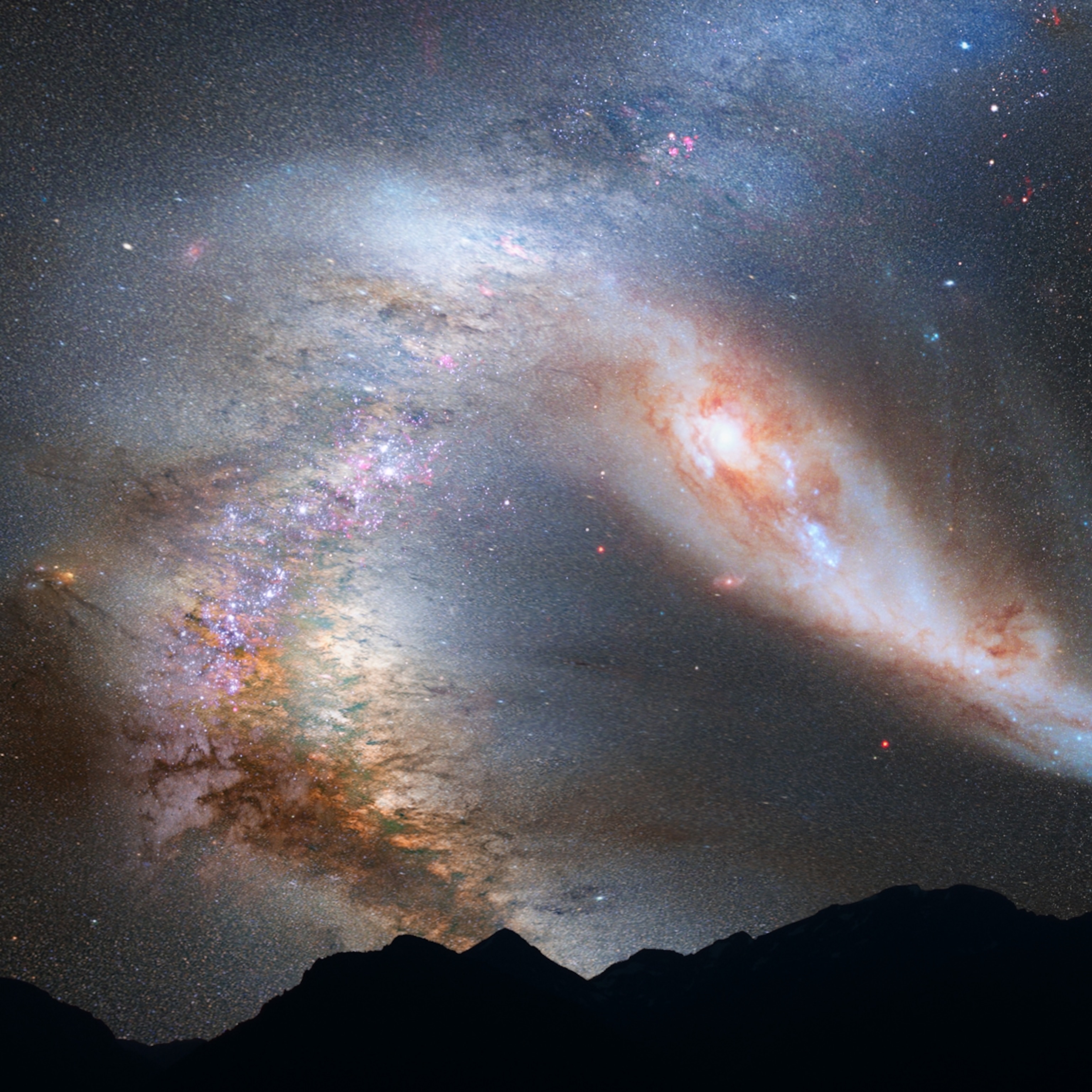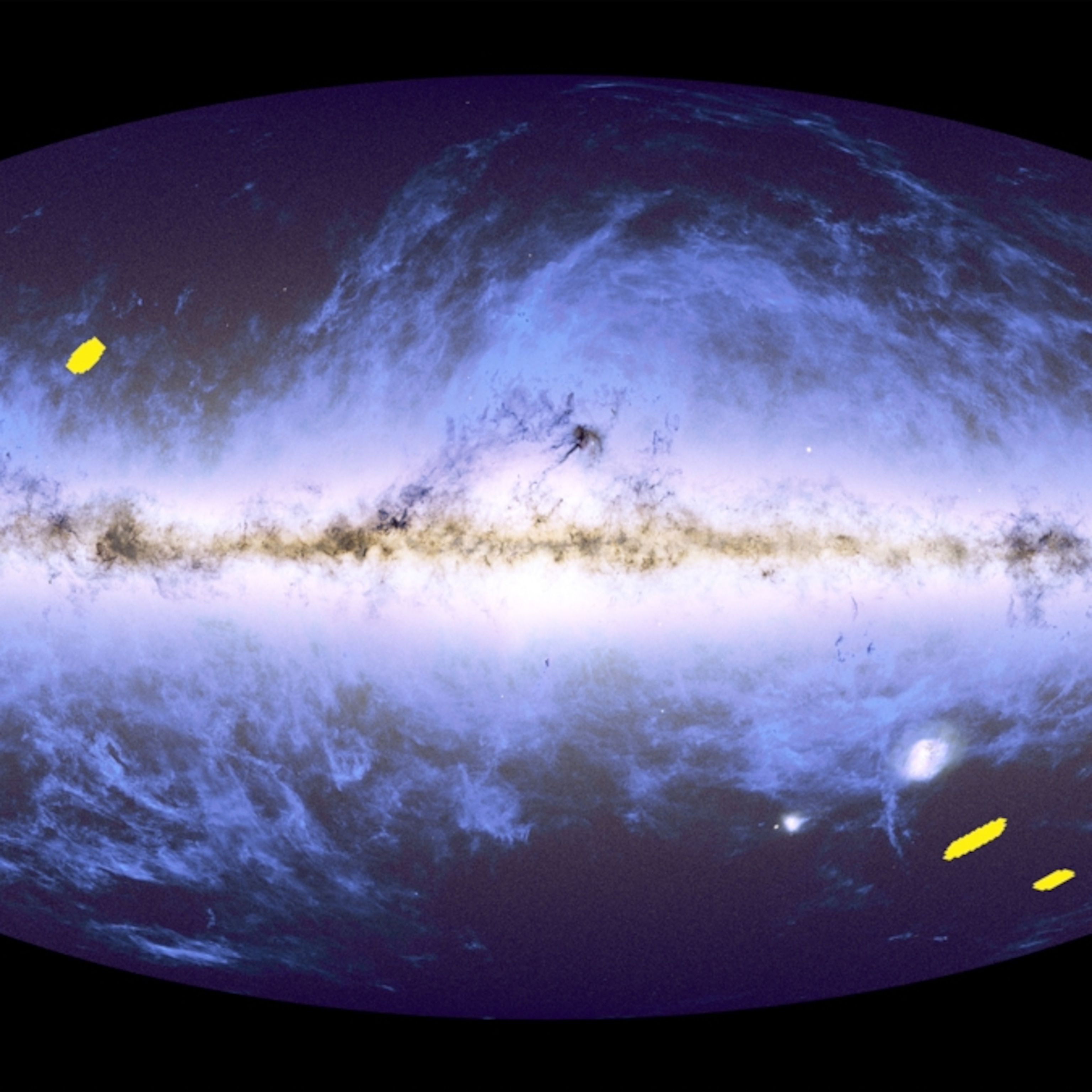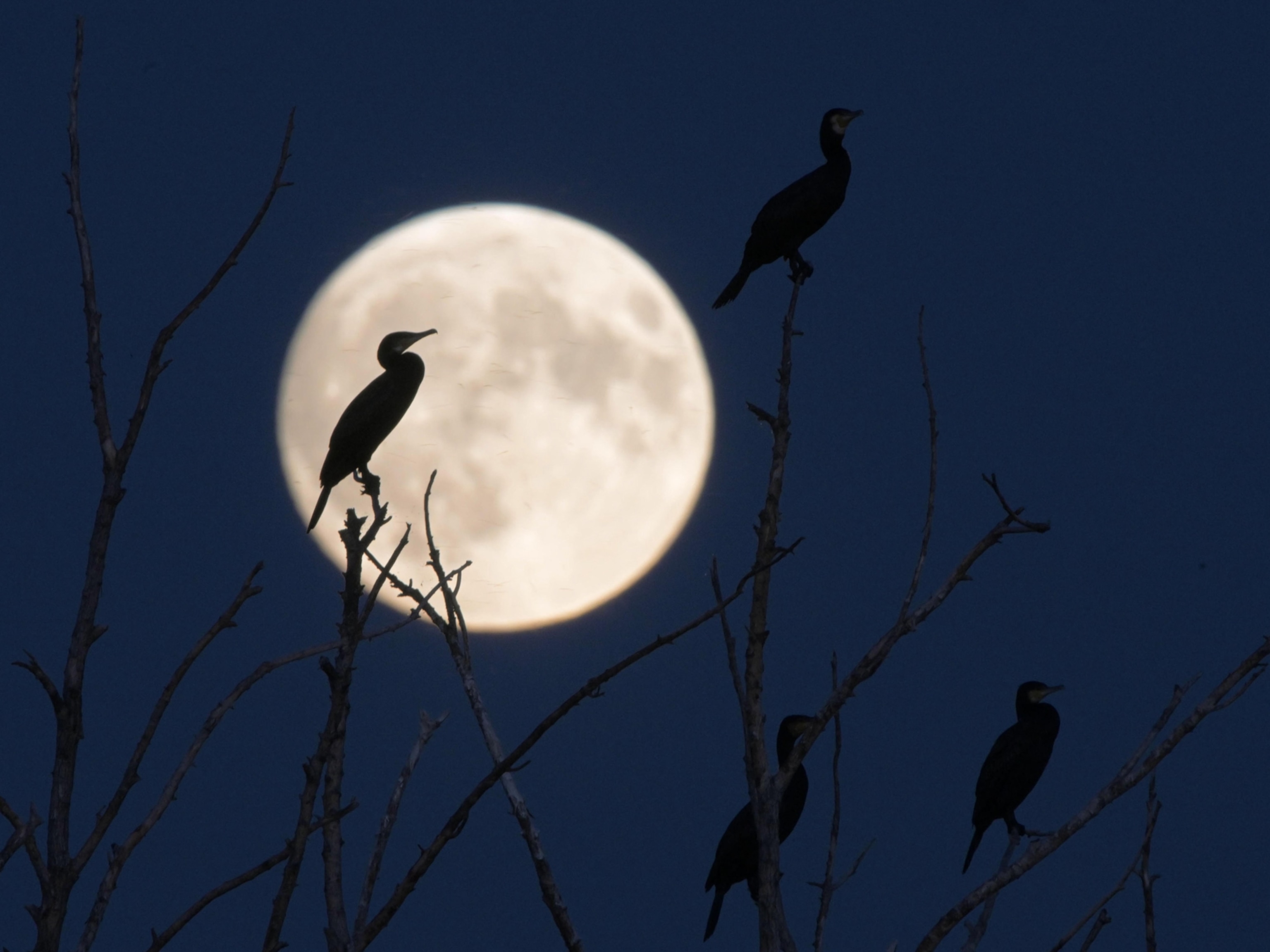
These oddball galaxies are missing their dark matter
A pair of dim, puffy galaxies are devoid of this key cosmic ingredient. Now astronomers using the Hubble Space Telescope say they may know why.
In the cosmic equivalent of a total knock-out punch, two galaxies collided some eight billion years ago and kicked the gas out of each other.
That’s the latest explanation for a cosmic mystery that’s had astronomers scratching their heads since 2018: two dim, puffy galaxies that appear to be completely devoid of dark matter. New observations suggest those galaxies could be part of a string of similarly bizarre objects–the debris from the galactic smashup.
Detailed studies those two galaxies, called DF2 and DF4, had previously revealed that they are inhabited by strange, luminous star clusters. But scientists have been struggling to explain how these galaxies could exist at all, because dark matter—which makes up more than 80 percent of the matter in the universe—is considered an essential ingredient for building galaxies.
A new theory from a team led by Yale University’s Pieter van Dokkum suggests the cosmic wreck can account for these space oddities, as well as other characteristics of the debris field. “During the collision, the gas gets stripped and shocked, and it turns into this chaotic environment with no dark matter to keep it together,” van Dokkum says. “And then parts of that big irregular gas cloud can separate from the rest of the gas cloud and form their own little galaxies.”
The scenario van Dokkum and his colleagues envision will require confirmation from future observations. But if it’s correct, it’s an elegant way to explain how such an odd string of galaxies emerged. And as described recently in the journal Nature, this galactic collision might even help scientists understand some fundamental properties of dark matter itself.
“To me it has the ring of truth,” van Dokkum says. “It’s one very simple explanation that is the only thing so far that explains this wide range of properties—that we have globular clusters [of stars], two identical galaxies that have no dark matter, this weird trail that we now found—it all fits.”
The invisible matter of the universe
Normally, most of a galaxy’s heft comes from dark matter. In the late 1960s the astronomer Vera Rubin surmised as much when she inferred that something massive and invisible must be keeping stars on the fringe of the Andromeda Galaxy from flying off into space. Without that gravitational glue, those stars would be lost—as would stars on the edges of multiple other rotating galaxies.
A half-century after Rubin’s work, astronomers still have never directly observed dark matter. It doesn’t emit or reflect light. It doesn’t directly interact with ordinary matter, though its gravity affects how observable objects such as stars and galaxies behave. Scientists also think dark matter is required for galaxies to amass enough gas to begin birthing stars.
But in 2018 van Dokkum spotted a galaxy called NGC1052-DF2, or DF2 for short, that appeared to be extremely deficient in dark matter. About 72 million light-years away, near a large elliptical galaxy, DF2 was mostly dark and diffuse, peppered with an unusual array of extremely bright, massive star clusters. When van Dokkum and his colleagues calculated the galaxy’s mass, they realized that DF2 contained at most a smidgen of dark matter.
“The initial discovery was indeed surprising, also to us—we had no explanation for that object,” van Dokkum says. “And so we had this object that we couldn’t explain, but then went on to use it, basically, to make a lot of claims about important topics, and I think that combination made a lot of people sit up and take notice, but also be skeptical.”
Since then, van Dokkum and his colleagues have verified many of the characteristics originally observed in the galaxy. “We were lucky that we were right—it did not have to be that way,” van Dokkum says, chuckling. And in 2019 they spotted another galaxy in the same group, called DF4, that’s almost identically peculiar. It, too, is faint and diffuse, seemingly dark-matter-deficient, and punctuated with bizarre clumps of stars.
“You have two galaxies that both are unique, by themselves. There is no other galaxy in the universe that looks like them—except the other,” van Dokkum says.
A different group of astronomers has spotted at least one other galaxy that seems to be oddly low in dark matter, although that galaxy’s orientation makes it harder to measure than DF2 and DF4.
But the real question is, how the heck did these strange galaxies form in the first place?
Rewinding the astronomical clock
In 2019 and 2020 van Dokkum and his colleagues aimed the Hubble Space Telescope at DF2 and DF4. They realized that DF2 was much farther away and that the two funky galaxies were zooming away from one another. That means if you played those galaxies’ movements on rewind, they would eventually converge on the same point in space: the supposed site of an ancient, high-speed collision.
When the two original galaxies collided, their dark matter fractions kept right on going, zooming through space like nothing happened. But all their gas ended up in a messy, hot, high-pressure heap—the exact type of environment where large, massive clusters of stars like the ones in DF2 and DF4 can form.
Simulations of such collisions suggest that the initial gas heap broke into pieces and spread out over billions of years, leaving a trail of dim, fluffy, featherweight galaxies. And when van Dokkum and his colleagues took a look at a deep image of the NGC 1052 group, they found as many as 11 galaxies—including DF2 and DF4—in a row.
“We had these puzzling observations, and suddenly they clicked—and then we had these predictions, like you should see more galaxies along this axis, and then we saw them,” van Dokkum says.
Bookending the trail are two galaxies that van Dokkum says could be the dark-matter-rich remnants of the original colliding galaxies, but confirming that will be a challenge because the galaxies are very faint and tough to observe in detail.
Untangling the clues in the sky
Even though questions remain about this potential galactic pileup, some scientists think it’s a plausible explanation for how those dark-matter-deficient galaxies formed and grew.
“It’s attractive for a few reasons,” says Mike Boylan-Kolchin of the University of Texas at Austin, who studies dark matter and galaxy formation. “The biggest is that it explains several aspects of the system simultaneously.”
If the scenario is correct, Boylan-Kolchin adds, it helps astronomers better understand how “sticky” dark matter is—whether it ignores itself like it ignores ordinary matter, or if there’s a degree of self-interaction. And, he says, one particularly nice consequence of the galactic collision is that it explains the odd star clusters in DF2 and DF4.
“One of the big puzzles in these systems is that they seem to have these very overly massive star clusters, and why should that be?” Boylan-Kolchin says. “This galaxy-galaxy collision really gives you the mechanism to produce the extra set of more massive clusters.”
Other astronomers, however, aren’t yet as convinced.
“It’s all the beginning of a great mystery, in a way,” says the University of Surrey’s Michelle Collins, who studies galaxy formation. She says the scenario is extremely speculative at this point, and we don’t know whether the proposed progenitor galaxies contained enough mass to produce what van Dokkum and his colleagues are observing.
Knowing the distances to all 11 galaxies that make up the supposed debris trail is also crucial for testing whether they’re part of the same system or if they are serendipitously aligned in a way that just makes them look related—the same way stars at wildly different distances from Earth can appear close in constellations.
“There’s just not enough data at all to rule out that these galaxies aren’t a constellation that we’re seeing,” she says. “It’s tempting to ascribe meaning to patterns.”
Confirming the collision theory will take time, but van Dokkum says it has testable predictions. For example, he’s keen to study the stellar clusters in DF4 and compare their ages to those in DF2. If those ages match, it would strongly suggest the two galaxies share an origin story.
He’s also going to aim Hubble at other suspected members of the debris trail to see whether they have the same strange star clusters, as well as measure their distances and determine whether they are in fact part of the same structure.
If he and the team get lucky, they could even take a close look at the two faint galaxies on either end of the trail and attempt to figure out whether they are the dark matter-dominated remnants of the original galaxies. But that’s a project that might need to wait for the next generation of ground-based telescopes—or for NASA’s James Webb Space Telescope.
“That would be amazing,” van Dokkum says. “Measuring those galaxies would be the holy grail of this system.”








